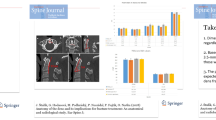Summary
The attachment point of the transverse lig. of the atlas was investigated in a series of 234 human skeletons of different ages and 42 cadaver dissections. This attachment point was found to be a bony bump at the lateral mass of the atlas which we called thecolliculus atlantis. These findings were confirmed by a retrospective study of more than 20.000 radiographs of the cervical spine. Furthermore, the study showed that thecolliculus atlantis is developed by age 13 at the latest and that it is visible in the open-mouth view radiograph. The rare absence of thecolliculus atlantis in the adult was found to be associated with lack of tension in the transverse lig. and thus at its attachment points due to dysfunction of the craniocervical joints. This dysfunction may be congenital (e.g. Morquio's syndrome, Kniest's syndrome) or acquired before age ten (e.g. trauma). In conclusion, the attachment point of the transverse lig. was found to be a product of normal function of the craniocervial junction and changes in the morphology and site of thecolliculus atlantis in certain inflammatory processes (e.g. juvenile chronic polyarthritis, salmonellar spondylitis) or injuries (Jefferson's fracture) allow an early diagnosis followed by an early adequate therapeutic procedure
Résumé
La zone d'insertion du lig. transverse de l'atlas a été étudiée sur une série de 234 squelettes humains d'âges différents et de 42 dissections cadavériques. Nous avons constaté que ce point d'ancrage correspond à un relief osseux de la masse latérale de l'atlas, que nous avons baptisé lecolliculus atlantis. Ces données sont appuyées par l'étude en pratique clinique de plus de 20 000 examens radiographiques du rachis cervical. Notre étude a montré que lecolliculus atlantis est développé au plus tard à l'âge de 13 ans, et qu'il est visible sur un cliché radiographique en incidence “bouche ouverte”. L'absence ducolliculus atlantis chez l'adulte s'est montrée rare et alors associée à un défaut de tension du lig. transverse et rapport avec sa zone d'insertion par un dysfonctionnement de la jonction crânio-cervicale. Ce dysfonctionnement peut être congénital (syndrome de Morquio, de Kniest) ou acquis avant l'âge de 10 ans (traumatisme). En conclusion, la zone d'insertion du lig. transverse de l'atlas résulte d'un fonctionnement normal de la jonction crâniocervicale, et des modifications de la morphologie ou de la situation ducolliculus atlantis dans certains processus inflammatoires (polyarthrite chronique juvénile, spondylite à salmonelles) ou traumatiques (fracture de Jefferson) permettent un diagnostic précoce, qui autorise une prise en charge thérapeutique également précoce et adaptée.
Similar content being viewed by others
References
Abrahams M (1967) Mechanical behavior of tendon in vitro. A preliminary report. Med Biol Eng 5: 433–443
Budin E, Sondheimer F (1966) Lateral spread of the atlas without fracture. Radiology 87: 1095–1098
Burgener FA, Kormano M (1993) Röntgenologische Differentialdiagnostik. Thieme, Stuttgart
Burguet JL, Sick H, Dirheimer Y, Wackenheim A (1985) CT of the main ligaments of the cervico-occipital hinge. Neuroradiology 27: 112–118
Daniels DL, Williams AL, Haughton VM (1983) Computed tomography of the articulations and ligaments at the occipito-atlantoaxial region. Radiology 146: 709–716
Dirheimer Y (1977) The craniovertebral region in the chronic inflammatory rheumatic diseases. Springer-Verlag, Berlin Heidelberg
Dvorak I (1988) Rotationsinstabilität der oberen Halswirbelsäule. In: Hohmann D, Kügelgen B, Liebig K (eds) Neuroorthopädie 4. Springer-Verlag, Berlin Heidelberg, pp 37–60
Fielding JW, Cochran GVB, Lawsing JF, Hohl M (1974) Tears of the Transverse lig. of the atlas. A clinical and biomechanical study. J Bone Joint Surg 56: 1683–1691
Gehweiler JA, Osborne RL, Becker RF (1980) The radiology of vertebral trauma. Saunders, Philadelphia
Greenspan A (1993) Skelettradiologie, Orthopädie, Traumatologie, Rheumatologie, Onkologie. VCH, Weinheim
Gutmann G (1981) Die Halswirbelsäule. Die funktionsanalytische Röntgendiagnostik der Halswirbelsäule und der Kopfgelenke. Fischer, Stuttgart
Henle J (1871) Handbuch der systematischen Anatomie des Menschen. Knochen, Bänder, Muskeln, 3rd edn. Vieweg & Sohn, Braunschweig, p 50
Jefferson G (1920) Fracture of the atlas vertebra. Report of four cases, and a review of those previously recorded. Br J Surg 7: 407–422
Kattan KR (1979) Two features of the atlas vertebra simulating fractures by tomography. Am J Roentgenol 132: 963–965
Keats TE (1978) Atlas radiologischer Normvarianten. Enke, Stuttgart
Köhler A, Zimmer EA (1989) Grenzen des Normalen und Anfänge des Pathologischen im Röntgenbild des Skeletts. Thieme, Stuttgart
Lang J (1991) Klinische Anatomie der Halswirbelsäule. Thieme, Stuttgart
Meghrouni V, Jacobson G (1959) The pseudonotch of the atlas. Radiology 72: 260–262
Murray RO, Jacobson HG (1977) The radiology of skeletal disorders. Churchill Livingstone, London
Reiser M, Peters PE (1995) Radiologische Differentialdiagnose der Skeletterkrankungen. Thieme, Stuttgart
Resnick D, Niwayama G (1988) Diagnosis of bone and joint disorders. Saunders, Philadelphia
Schmorl G, Junghanns H (1968) Die gesunde und die kranke Wirbelsäule in Röntgenbild und Klinik. Thieme, Stuttgart
Schwarz N, Putz R, Buchinger W (1996) Isolierte Ossikel am Dens axis. Unfallchirurg 99: 223–227
Spence KF, Decker S, Sell KW (1970) Bursting atlantal fracture associated with rupture of the Transverse lig. J Bone Joint Surg 52: 543–549
Thelen M, Ritter G, Bücheler E (1993) Radiologische Diagnostik der Verletzungen von Knochen und Gelenken. Thieme, Stuttgart
Töndury G (1958) Entwicklungsgeschichte und Fehlbildungen der Wirbelsäule. Hippokrates, Stuttgart
Von Torklus D, Gehle W (1987) Die obere Halswirbelsäule. Thieme, Stuttgart
Viehweger G (1956) Die Darstellung des medialen Randes der kranialen Gelenkfläche des Atlas auf den Übersichtsaufnahmen der HWS im ventrodorsalen Strahlengang. Röfö 84: 492–493
Author information
Authors and Affiliations
Rights and permissions
About this article
Cite this article
Weiglein, A.H., Schmidberger, H.R. The radio-anatomic importance of thecolliculus atlantis . Surg Radiol Anat 20, 209–214 (1998). https://doi.org/10.1007/BF01628897
Received:
Accepted:
Issue Date:
DOI: https://doi.org/10.1007/BF01628897




